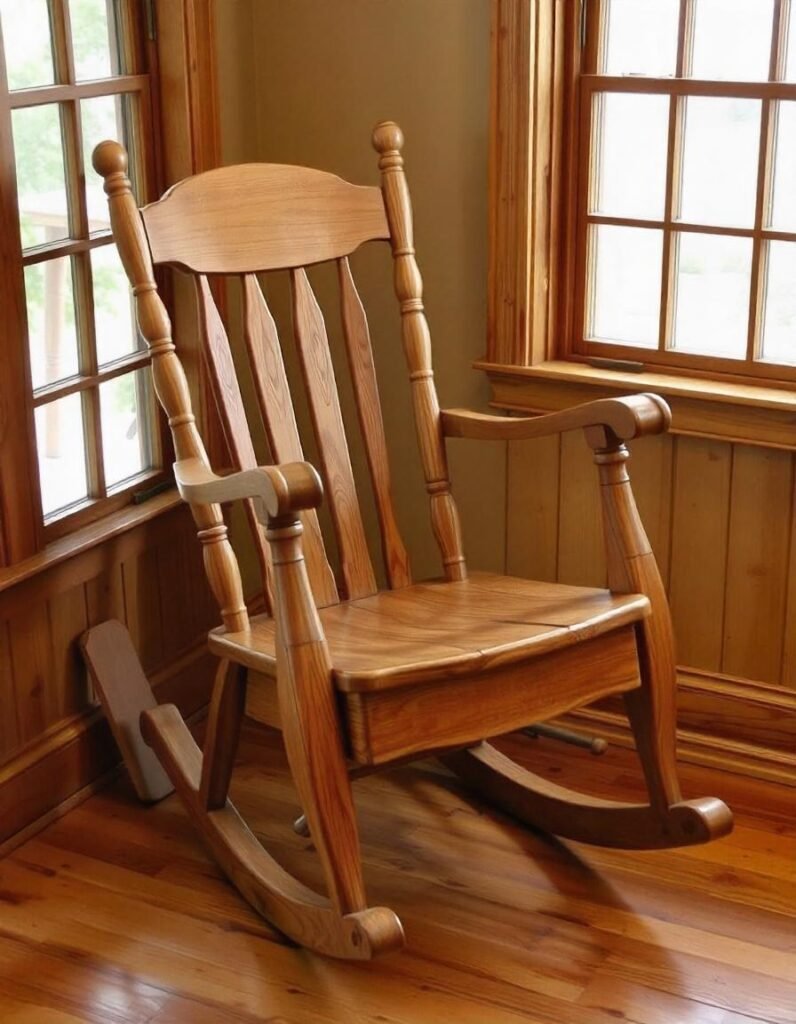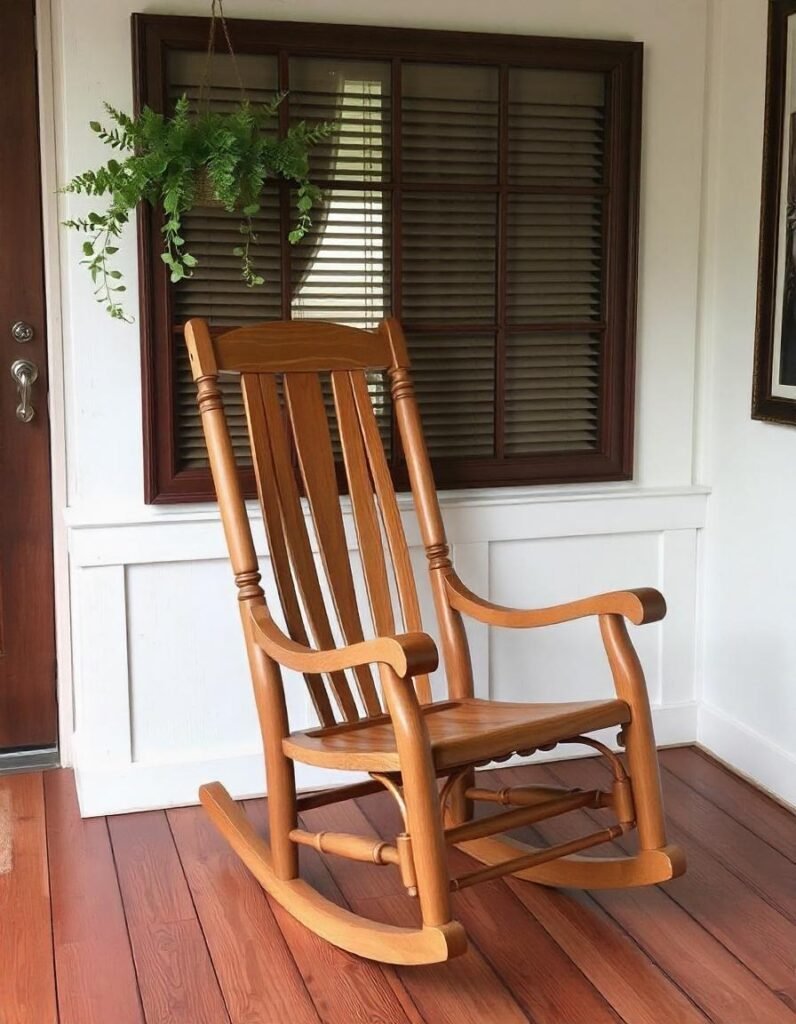Don’t Miss Out! Download Your Free Woodworking Guide Now!
A rocking chair is not just a carpentry project; it is an opportunity to create a piece of furniture that will appreciate in value over many future generations. One piece of furniture that meets so much in credit, from functionality and comfort to classic beauty, is the rocking chair. This gives it universal usage in homes across the world. The gentle swing of a rocking chair could lull a baby to sleep, be a place for thought, or simply be a comfortable setting to relax at the end of a long day. Building a handmade wooden rocker helps you put a little of your own style and flair into a product that will soon be a cherished family heirloom.

You might be an experienced woodworker or a novice woodworker who wants to test yourself on a fulfilling project; the main thing you need is detailed plans for the same. We guide you through the process so that you can start making a rocking chair of your own—from selecting the right materials, to assembling and finishing your project for high-quality results that you will be proud of.
1. Select the Best Wood for Your Rocking Chair
The measure of the success of a woodworking project is in the choice of the right materials; nowhere is this more important than in a rocking chair. The type of wood chosen can determine the durability, comfort level, and attractiveness of the chair. You will need to use the type of wood that will not only give you the design and style you envision but also offer the strength necessary to support users over some reasonable time as it rocks to and fro.
Popular Wood Choices:
Oak is among one of the best choices for rocking chairs because it is strong, highly resilient, and possesses a very distinct grain pattern. It is extremely hard wood that never loses its integrity, no matter how much it’s moved. Its classic look goes well with traditional designs, and oak can be stained into a variety of finishes to fit any décor.
Maple: Another hardwood, maple is popular for furniture making. It’s recognized with fine, even texture and because it does not easily wear. Maple is a good wood if you are really looking for a smooth modern effect with clean lines. Its light color and the fact that it will take stain well make it versatile for different styles.
Cherry: Coveted for its rich, dark color that gains depth with age, cherry seems to infuse character into the furniture as it travels through the years. The smooth grain in cherry makes it perfect for elegant, refined designs. It is a bit softer compared to oak and maple but still sufficiently durable to stand years of rough use.
Pine: Pine is a softwood. This is more easily worked and cheaper, making it a good material for the person just starting in woodworking. Although it is not as durable as hardwoods, a pine rocker will still look great and be very acceptable, particularly for indoor applications. Pine is rustic and attractive, and correctly finished, will lend itself nicely to the model.
Other Materials:
High-Quality Wood Glue: This will give long-lived joints, which hold the chair together well.
Screws or Dowels: The joints of the chair would require the same to hold up, be firm, and bear the weight of the user.
Sandpaper of Various Grains: This will be used to reduce rough edges and prep the wood for finishing.
Finishing Products (Stain, Varnish, or Paint): These will be used to protect the wood, enhance its appearance, and make the chair look beautiful while giving it the look that will stay for years to come.
Tip: Think about the kind of environment in which the chair will be used. If, for example, it is going to be used outside, use a wood with natural resistance to moisture and decay, such as cedar or teak, and use a protective finish against the elements.
Don’t Miss Out! Download Your Free Woodworking Guide Now!
2. Gathering Tools and Preparing the Workspace
Your rocking chair project wouldn’t be a success without the right tools and a well-organized workspace. A well-equipped shop will allow you to work more efficiently and safely, with fewer errors and the finest possible finish.
Required Tools:
Miter Saw: When it comes to accurate angled cuts, a miter saw is one of the best tools for the job, as some parts of it are very important for the chair, such as its legs and rockers. A miter saw can help make quick, accurate cuts so that all components will perfectly fit.
Jigsaw or bandsaw: Any one of these tools would serve to cut the curved shapes in the rockers and the armrests. Being able to cut smooth, fair curves would definitely be a plus in the quest for a comfortable, functional rocking chair.
Drill and bits: A drill is needed for making pilot holes which allow screws to be inserted into wood without splitting it. It is also used in driving screws to hold pieces snug-together and in fitting any hardware.
Clamps: The clamps hold the pieces on the chair so that the glue can dry for it to really solidify the joints and fix the parts in one position.
Tape Measure and Square: All measuring is important in woodworking. A measuring tape and a square tool assure you of sharp cuts and perfect right angles, which will get everything right in a place, especially for a project like a rocking chair.
Sanding Tools: To level wood surfaces, especially at joints and edges, either an orbital sander or hand sandpaper is required. It is indispensable for prepping wood prior to finishing and attains a professional look for the final product.
Paintbrushes or Sprayer: Use to apply varnish, stain, or paint on the chair. The distribution of the finish ought to be fairly even for good looks as well as the strength of the chair.
Workspace Preparation
Heavy-Duty Workbench: Should be large enough to accommodate long wood planks, like the rockers and backrest. And to be honest, a good workbench marks the inception of any successful woodworking project.
Begin with Organizing Tools – an organized set of tools remains important and easy to handle, plus it makes the building process run smoothly without any interruptions, other than simply wasting time, provokes frustration, and increases the probability of mistakes.
Providing Adequate Lighting – this is very important in ensuring proper measurement for cutting and joining. Lighting should help you see your work to avoid errors.
Ventilation: Good ventilation, especially during the application of finishes or adhesives, wards off the fumes. It’s much more pleasant to be in a well-ventilated workspace over the long run.
Tip: Safety. Always use your safety goggles to protect your eyes from sawdust and flying wood chips, gloves to protect hands from cuts and abrasions, and ear protection while using power tools.
Don’t Miss Out! Download Your Free Woodworking Guide Now!
3. Designing Your Rocking Chair
One of the most exciting parts of this project will be the designing of your rocking chair. It’s in this phase that you will finalize the kind of design, the size, and which features will make it different from the rest. A good design ensures not only that the chair will be comfortable and functional but also allows self-expression.

Choose the style: First up on the list of your style requirements is to choose the style of your rocking chair. Do you love the timeless elegance of a Windsor chair, the simplicity of Shaker design, or perhaps something more modern that has clean lines and finishes? Your choice is going to impact everything in the chair right from the choice of wood to the detail in the finish.
You will have been able to make your decisions using the style and hence do a rough sketch including the main components: seating, backrest, armrests, legs, and rockers. This should give you an idea concerning the proportions and general structure of the resulting chair.
Make a Plan: As soon as some ideas have been sketched, make a plan. On graph paper or in design software, draw up the dimensions, angles, and joinery techniques to be used for making the chair. This drawing should take into account ergonomic considerations related to the shape of the backrest and the angle of inclination at which the rockers should be placed to obtain optimum comfort.
Tip: Create a full-size template of the rockers and backrest to try the pattern. In this way, it is easy to know if your chair will work perfectly after cutting the final pieces
4. Shaping and Cutting of Wood Pieces
Your design is ready, so now you’re set to start cutting and shaping the wood. This is a bit delicate, for the reason that precise cuts and finis:hed shapings are necessary to ensure that all pieces fit together nicely.
Measure and Mark: Measure out each piece of wood really carefully against the blueprint and then clearly mark that measurement with a pencil in such a way that it’s clear how each cut is made. Make sure you double-check all the dimensions prior to cutting to avoid mistakes.
Cut the parts: cut straight with your miter saw for the chair’s legs and arms, among other components. Turn to a jigsaw or bandsaw for those curves in the design; for the rocker and armrests, just cut away. Be patient with the curved cuts you make; make them as smooth and even as you can.
Shape the Parts: After cutting the parts, the edges on each can be smoothed with sandpaper or a file. Pay particular attention to the rockers as they need a really smooth curve if the chair is going to rock gently and steadily. Proper shaping of wood in a chair is essential to both comfort and appearance.
Tip: As you cut, label each part; you don’t want to forget its place to fix it in the assembly—more so, it saves on time during assembly, and you will not experience a mix-up of parts when assembling the chair.
5. Chair Assembly
Assembling a rocking chair is where your project comes together literally. This is a point in time when patience and precision are important because each piece has to be fitted into the other carefully for the chair to be firm and well-balanced.
Steps:
Frame Assembly Assemble the main frame of the chair with the seat, legs, and backrest. Always remember that the joints get strong and durable as they are properly lined with dowels or screws and wood glue. Make sure first that all is properly aligned and squared before time allows the glue to dry.
Add the Armrests: Once the frame is done, secure the armrests to the chair. They need to be placed at a height and angle that are comfortably supportive without restricting movement. See to it that they are firmly attached to the frame.
Attach the Rockers: The rockers would possibly be the most vital part of the chair since it’s the rockers that determine how the motion is served. Place them on each side of the legs with great care and ensure they’re both balanced accordingly while placed at the right angle. A well-fitted rocker provides a smooth, even rocking motion.
Tip: Clamps work great at holding the pieces in position while the glue is drying. This will assure that your joints are secure and firm, with no shifting or other misalignment that might affect your chair’s balance.
Don’t Miss Out! Download Your Free Woodworking Guide Now!
6. Sanding and Finishing Your Rocking Chair
The final steps in your project are the sanding and finishing, which elevate your chair from a mere assemblage of woods to a shiny, professional piece of furniture. This is the most crucial stage in improving the appearances of your chair and protecting it from wear and tear.
Steps:
Sand the chair down. Sand with the use of a sander on bigger surfaces, and sandpaper the joints and edges by hand. Make the first sanding with a rougher grain for rough disappearance and then change to finer grainings for finishing. Give special attention to joints and edges; make sure they are very smooth.
Apply a Finish: The type of look that will be gained on the chair will determine whether a stain, paint, or varnish is going to be applied. A stain brings out the natural beauty in the grain of the wood, while paint can give a pop of color or, overall, match the chair to your existing decor. Apply the finish in thin, even coats, letting each coat dry fully before applying the next. Use a weather-resistant finish on outdoor chairs to protect them against elements.
Final Touches: Once the finish is dry, you may want to add cushions for extra comfort or a clear coat of protection in order to make it more durable. This is especially true for a chair that is going to be placed outdoors. Decorative elements such as carvings or stenciling can also be added in this stage of the process to further personalize the chair.
Tip: Apply the finish in a well-ventilated area, using long, smooth strokes, to prevent streaking. A well-applied finish doesn’t just enhance the chair’s beauty but also protects the wood from damage, thus prolonging the life of the chair.
Conclusion
A rocking chair can prove one of the most exciting endeavors in woodworking, one full of skill, creativity, and function. With these plans, you will make a customized rocking chair that is beautiful and great to look at, but it can provide a nice, comfortable, and relaxing corner in your house for proper relaxation. The chair you will make can be classical in style, or it can be modern in style—it can be a real valuable item to testify to your handiness and a little bit of your touch of individuality. You will watch your handmade rocking chair turn into that very special piece of furniture with the right materials and tools, keeping a keen eye on detail, bringing sense and comfort to your family for years to come. With each gentle rocking movement on the rocker you created with your hands, you feel a sense of being proud and very much satisfied with yourself—an admirable self-satisfaction only from the completion of a very meaningful project in the world.

